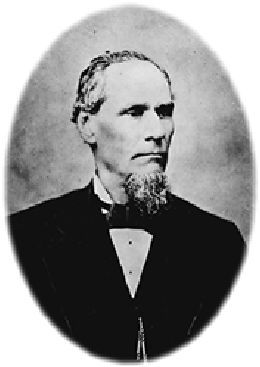In September or October 1853, the first wagon train succeeds in crossing rugged Naches Pass through the Cascade Mountains north of Mount Rainier, near where the borders of present-day Yakima, Kittitas, Pierce, and King Counties meet. The train of more than 30 wagons includes James and Virinda Longmire and their children, who have traveled with several other families from their home in Indiana to settle in Western Washington.
The Longmires and their children Elcaine, David, John, and Tibatha, left Indiana on March 6, 1853, with a number of other emigrants including John Lane, Arthur Sargent, John Moyer, and Van Ogle. They traveled by steamboat to St. Joseph, Missouri, where they bought wagons and oxen and followed the "emigrant trail" to Oregon Territory. After an arduous journey of several months, they reached Umatilla, Oregon. Here the Longmire party and others who joined with them along the way left the relatively well-known Oregon Trail and struck for Fort Walla Walla in Washington Territory. From there they would head directly for Puget Sound over the Cascade Mountains.
At the Summit
By late September, the more than 30 wagons had reached the upper Yakima Valley and crossed over to the Naches River. They followed the Naches for four days, crossing it 52 times according to James Longmire's later recollection (Rice, 15). Leaving the river bed, the wagon train followed a ridge between the North and Middle Forks of the Little Naches River toward the Cascade summit, which they reached in three days. Here there was a rich prairie of fine grass and good water, known then as Summit Prairie and today as Government Meadow, where they waited two days to rest their oxen. Three more miles took them to Summit Hill, the top of Naches Pass, and a precipitate, nearly vertical descent of several hundred yards.
At the time, there was no road down this descent, and no alternative route for the wagons. For many years Indians had used the trail over Naches Pass in hunting and to cross the Cascades between Puget Sound and the Yakima Valley. Settlers had also crossed the pass, but only on foot or horseback. For some years, settlers had been pushing for construction of a wagon road over the pass from Walla Walla to Steilacoom, and indeed money had been allocated and a road crew sent out. However, the crew's supplies ran out, and it had left for the season before reaching the pass.
A Difficult Descent
With no other option, the settlers lowered the wagons down the incline one at a time by rope, with one end tied to the wagon axles and the other looped around a tree and held by several men who let it out gradually. Once the steepest descent was accomplished, the oxen drew the wagon with its wheels still locked another quarter mile downhill. Amazingly, all the wagons were lowered safely except that of the Lanes -- that family finished the journey on horseback.
As the men lowered the wagons, the women and children followed the circuitous Indian trail down the slope. Along the way, Virinda Longmire was surprised to meet a lone white man, Andy Burge, who turned out to be belatedly packing food for the road crew. Burge tried unsuccessfully to persuade the party that the country ahead was too rough for the wagons, then left them the food and returned to Puget Sound, leaving notes along the way to help guide the wagon train. After more hard traveling and many river crossings along the Greenwater and White rivers, the party emerged into the long-sought lowlands of Puget Sound, reaching Fort Steilacoom on October 9, 1853.
A second emigrant wagon train crossed Naches Pass three weeks later, and a wagon road was soon established. The Longmires went on to settle on Yelm Prairie and to play a major role in the exploration and development of Mount Rainier. James Longmire became a sought-after guide to the area, assisting the first known expedition to reach Rainier's summit, in 1870, and climbing it himself in 1883. That year he also discovered the hot springs at what is now called Longmire along the Nisqually River southwest of Mount Rainier's summit, which the family developed into a major tourist destination. Longmire's sons followed in his footsteps as guides and explorers on Mount Rainier, and named many of the features around the mountain.

